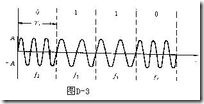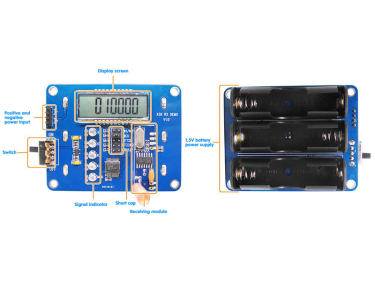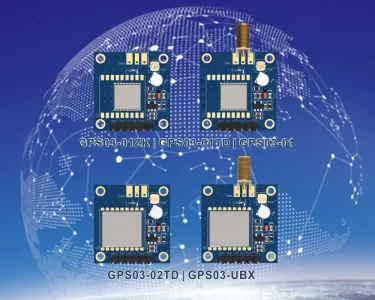Comparison of several common modulation methods for wireless modules
At present, there are many types of common wireless module on the market. The differences between them are often reflectedin the supported frequency, maximum rate, modulation method, power consumption,etc. This article compares several modulation methods commonly used in wireless module.
ASK definition
ASK is short for Amplitude Shift Keyingmodulation. For example, binary, and the binary symbols 0 and 1 are representedby different amplitudes respectively, which is ASK.
"Amplitude Shift Keying", also known as "Amplitude Shift Keying", is called ASK, and is a common method of modulation technology. If the possible state of the digital modulation signal corresponds to the binary information symbol or its corresponding baseband signal state one-to-one, the modulated signal is called a binary digital modulation signal. Keying with binary information symbols is called binary amplitude keying and is represented by 2ASK.

Shift Keying Schematic
In the “amplitude shift keying” mode, when “1” appears, the carrier with amplitude A is turned on, and when “0” appears, the carrier is turned off. This is equivalent to moving the original baseband signal (pulse train) spectrum to side.
Amplitude shift keying (ASK) is equivalent to amplitude modulation in an analog signal, except that it is a binary number multiplied by a carrier frequency signal. Amplitude shifting uses frequency and phase as constants andamplitude as variables. Information bits are transmitted through the amplitudeof the carrier. Binary amplitude keying (2ASK), because the modulation signalhas only two levels of 0 or 1, the result of the multiplication is equivalent to turning the carrier frequency off or on. The practical significance is that when the modulated digital signal is "1 ", The carrier is transmitted; when the modulated digital signal is" 0 ", the carrieris not transmitted. The principle is shown in Figure 1, where s (t) is a baseband rectangular pulse. Cosine signals are generally used for carrier signals, and modulated signals are used to convert digital sequences intounipolar baseband rectangular pulse sequences, and the role of this on-offkeying is to multiply this output by the carrier to shift the spectrum to thecarrier frequency. Nearby, realize 2ASK. The realized 2ASK waveform is shown inFigure 2.

2ASK waveform
The simplest and most commonly used form of amplitude modulation keying for this modulation technique is switching. The presence of a carrier isrepresented by a "1" and the absence of a carrier is represented by a"0". This type of modulation is called on-off keying (OOK), and it is the most energy-efficient modulation method because it radiates energy only when a "1" is sent. Amplitude shift keying requires a high signal-to-noiseratio to demodulate the signal, because according to its characteristics, most signals are transmitted at very low power. The advantages of the ASK modulated radio frequency system are that the structure of the transmitting and receiving equipment is simple, and the power consumption is relatively low.Unfortunately, the bandwidth occupied by the ASK / OOK modulation system is less than 500KHz or the peak density will not fall into the range required bythe "digital modulation system". This shows that the transmission power of the ASK / OOK modulation system is limited to 50mV / m, or some FHSS technology must be adopted to meet the requirements of FCC clause 15.247.
OOK
On-Off Keying
OOK is a special case of ASK modulation. If one amplitude is 0 and the other is non-zero, it is OOK. Binary on-off keying(OOK: On-Off Keying), also known as binary amplitude keying (2ASK), is aunipolar non-return-to-zero code sequence to control the opening and closing ofa sine carrier. This modulation method appeared earlier than the an alog modulation method, and the Morse code radio transmission uses this modulation method. OOK's anti-noise performance is not as good as other modulation methods, so this modulation method is not used in current satellite communicationand digital microwave communication. However, because the modulation method is simple to implement, in fiber-optic communication systems, amplitude keying method widely used. The analysis method of this modulation method is basic, so you can study the basic theory of digital modulation from the entry of OOK modulation method.
FSK (frequency shift keying)
An angular modulation in which the frequency of a sinusoidal oscillation changes between a set of discrete values,where each discrete value represents a characteristic state of a time-dispersed modulated signal.
Applied disciplines: communication technology (first-level discipline); communication principles and basic technologies (secondary discipline)

Frequency shift keying uses two oscillators with different frequencies F1 and F2 to represent signals 1 and 0. Use 1 and 0 of the digital signal to control two independent oscillation sources to output alternately.For binary frequency shift keying modulation, its effective bandwidth is B =2xF + 2Fb, where xF is the bandwidth of the binary base band signal and them aximum frequency offset of the FSK signal. Since the bandwidth of the digital signal is the Fb value, the binary frequency shift key The signal bandwidth of the control is relatively large, and the frequency band utilization is small.
GFSK
Gaussian frequency shift keying GFSK-Gauss frequency Shift Keying, is a Gaussian low-pass filter before modulation tolimit the signal's spectral width.
Modulation principle
GFSK Gaussian frequency shift keying modulation is a digital modulation method in which input data is pre-modulatedand filtered by a Gaussian low-pass filter, and then FSK modulated. While maintaining a constant amplitude, it can control the spectrum of the modulated signal by changing the 3dB bandwidth of the Gaussian low-pass filter. It has the characteristics desired by wireless communication systems such as constantamplitude envelope, concentrated power spectrum, and narrow spectrum.Therefore, GFSK modulation and demodulation technology is widely used in manyfields such as mobile communications, aviation and marine communications.
GFSK modulation can be divided into direct modulation and quadrature modulation.
Direct modulation
Direct modulation is to directly simulatethe frequency modulation of the RF carrier after the digital signal is filteredby Gaussian low-pass. When the modulation index of the frequency modulator is equal to 0.5, it is the well-known GMSK (Gaussian Minimum Frequency ShiftKeying) modulation, so GMSK modulation can be regarded as a special case of GFSK modulation. In some literatures, the GFSK modulation method with different BT product and modulation index is called GMSK / FM, which actually notices the fact that this method cannot be called GMSK when the modulation index is no tequal to 0.5.
Although the direct modulation method is simple, because the modulation signal is usually added to the VCO of the PLL frequency synthesizer, its inherent loop high-pass characteristic will causethe low-frequency component of the modulation signal to be lost. Therefore, inorder to obtain the ideal GFSK modulation characteristics, a direct frequency modulation technique called two-point modulation is proposed. In this technique, the modulation signal is divided into two parts, one part is addedto the VCO end of the PLL according to the conventional frequency modulation method, and the other part is added to the main oscillator end of the PLL.Because the main oscillator is not in the control feedback loop, it can be modulatedby the low-frequency component of the signal. In this way, the generated composite GFSK signal has spectral characteristics that can be extended to DC,and the modulation sensitivity is basically a constant, which is not affectedby the loop bandwidth. However, two-point modulation increases the difficultyof GFSK modulation index control.
Quadrature modulation
Orthogonal modulation is an indirect modulation method. In this method, a digital signal is subjected to Gaussianlow-pass filtering and an appropriate phase integration operation, and then divided into two parts: in-phase and quadrature. The in-phase and quadrature components of the carrier are multiplied respectively, and then the GFSK signalis synthesized. Relatively speaking, the physical concept of this method is clear, and it also avoids the damage of the signal spectral characteristics during direct modulation. On the other hand, GFSK parameter control can beimplemented in a Gaussian filter with a calibration factor, and is not affectedby the subsequent frequency modulation circuit, so the parameter control is simpler. Because of this, the baseband signal processing of the GFSK quadrature modem is particularly suitable for digital implementation.
Partof the content comes from the Internet, please contact us if there is anyinfringement.
 +86-755-23080616
+86-755-23080616
 sales@nicerf.com
sales@nicerf.com
Website: https://www.nicerf.com/
Address: 309-314, 3/F, Bldg A, Hongdu business building, Zone 43, Baoan Dist, Shenzhen, China




